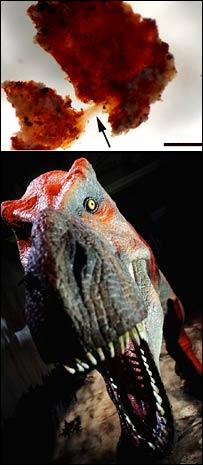Scientists in the US have found soft tissues in the femur of a Tynosaurus rex. For years, only dinosaur bones were studied. It will be impossible to produce DNA
Remains of soft tissue in a dinosaur fossil (above) and the dinosaur itself
For more than a century, the study of dinosaurs was limited to fossilized bones. Now, researchers have found remains of 70-million-year-old soft tissue that also ossified in addition to the bones, including what appear to be delicate blood vessels belonging to T. rex. Attempting to challenge previous conclusions in this hot field of dinosaur research, the work was received by scientists with praise and disbelief in equal measure.
Normally, when an animal dies, the worms and flies quickly eat all the soft parts. As the remains of the bone material is buried deeper and deeper in the mud, it heats up, crumbles and is replaced by minerals. He turns to stone. In this form and in no other form, it is all that remains of the original material. From the outside, fossil number 1125 in the Rock Museum also looks like this.
However, when Mary Schweitzer, from the University of North Carolina, she found within the sample, among the minerals, something unusual.
She discovered that the transparent filling of the bone looked like a blood vessel. There were also signs of what looked like red blood cells and others that looked like osteocytes, cells that build and maintain bones. It's a fossilized bone in the sense that it was made from an extinct animal but it doesn't have all the features necessary for a fossil," she told the BBC.
"If the scientists can isolate proteins from the material, it will be possible to learn new details about the way the dinosaurs lived," said Mary Higby Schweitzer from the University of North Carolina. The soft tissues were found inside a broken femur of the T. rex known as mor 1125, which was found in sandstone in Montana. The dinosaur was about 18 years old when it died.
"The blood vessels and their contents are identical to blood vessels of ostriches," the researchers said. Finding tissues inside fossils is a rare and unusual phenomenon, all the more so when it comes to a dinosaur of this size and from such an early period. Apart from the ability to learn about the delicate biology of the legendary reptiles, the discovery allows us to learn more about the way fossils are formed. CNN reported that although the researchers manage to manipulate the material and disassemble it relatively easily, it will not be possible to crack the DNA code of the dinosaur based on the findings.


3 תגובות
The article is very interesting. But it is not detailed enough, it is written that they discovered how the dinosaurs lived according to the find, but it is not written what they discovered about how they lived.
Amazing and very interesting article